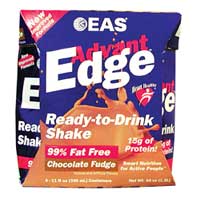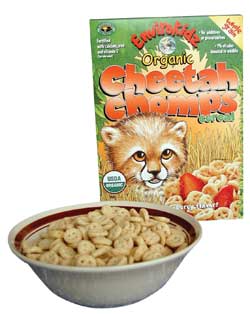
Inulin the Know
With the FDA's decision to recognize inulin as generally regarded as safe (GRAS), the awareness of inulin's benefits continues to increase. Inulin, one of the non-digestible oligosaccharides (NDO) extracted from natural sources, is one of a number of prebiotics making their way onto ingredient legends. The USDA's Food Safety and Inspection Service (FSIS) also has approved the use of inulin as a water binder, emulsifier, stabilizer and texturizer at a level between 2% and 5% in non-standardized meat food products. Furthermore, the FSIS is working to complete the rule to allow the use of any safe and suitable binder in foods that already permit the addition of binders.
NDOs help maintain gut health—reinforcing gut barrier function, stimulating the immune function and preventing harmful bacteria from establishing a home on the gut wall. Many inulin applications center around its health benefits, notably its properties as a soluble, prebiotic fiber. Detour, a whey protein energy bar from Next Proteins (Carlsbad, Calif.), provides 3g of dietary fiber per 80g serving, plus 148mg of calcium (15% of the RDA). However, the health-conscious will note the 5g of saturated fat in each bar, though each does offer 60% of the RDA for protein.
Shaking It Up
With prebiotics well-recognized for their nutraceutical effects, A.D. Westphalen, chemical engineering department, Iowa State University (Ames, Iowa), investigated the synergistic effects of inulin and xanthan gum in a paper presented at the 2002 Institute of Food Technologists (IFT) conference. Noting the use of inulin in such products as salad dressings, Westphalen proceeded to evaluate the influence of inulin concentration on the rheological behavior of xanthan solutions.
Below a critical value, Westphalen found relatively little effect, but above a critical amount, inulin and xanthan were shown to have a synergistic effect.

Dogged Out
A look at Mintel's GNPD shows several instances with chicory root extract (a source of inulin) in dog food. For example, Petsmart (Brockport, N.Y.) carries Nature's Plus dog food.Dogs, especially certain breeds, are disposed to certain skeletal health conditions. And, studies indicate that inulin increases calcium absorption to various extents. However, how beneficial this would be for canine companions is not necessarily clear.
“Relationship of Nutrition to Developmental Skeletal Disease in Young Dogs,” written by Daniel Richardson and Phillip Toll, both of the Science & Technology Center with Hill's Pet Nutrition Inc. (Topeka, Kan.), found, “Of the nutritional components, rate of growth, specific nutrients, food amounts consumed, and feeding methods influence skeletal disease. Excess energy and calcium are known risk factors.” Citing “Influences of Chronic Calcium Excess in the Skeletal Development of Growing Great Danes,” by H.A.W. Hezwinkel, et al., the authors found that giant-breed dogs eating food with excess calcium showed significant increases in the incidence of developmental bone disease. “The puppies were unable to protect themselves against the negative effects of chronic calcium excess.”

In the Bones
Calcium is just one of the minerals fortifying EnviroKidz Organic Cheetah Chomps Cereal from Nature's Path Foods (Blaine, Wash.). In this case, inulin plays a role in boosting both the absorption of calcium from the milk poured on the cereal as well as that in the Cheetah Chomps cereal itself, which has 10% of the RDA of calcium.Another application saw General Mills' (Minneapolis) Yoplait USA segment incorporate inulin into the Nouriche smoothies. These nonfat, drinkable yogurts boast 6g of fiber and 30% of the RDA of calcium.
The addition of prebiotics (specifically FOS) in yogurt applications served as the topic for a pair of research projects presented at the 2003 IFT conference. H.K. Voss, et al., with the Department of Food Science & Technology at the University of Nebraska (Lincoln, Neb.), explored “Functional Properties of Fructo-oligosaccharides in Nonfat Yogurt.” Sensory analysis discovered that the yogurts with FOS and inulin were regarded as smoother and thicker; in fact, yogurt with 4% FOS (on a weight/weight basis) had the highest overall acceptability.
R.W. Hutkins, also with the University of Nebraska's Food Science & Technology Department, explored the functional and microbiological properties of FOS in yogurt. The conclusion found “that FOS addition reduced the perception of sourness and increased sweetness. At high levels, yogurt containing FOS was smoother and more acceptable.”
Website Resources
www.PreparedFoods.com/archives/2001/2001_9/0901ns_ingredients.htm — "Prebiotics Enhance Gut Health" from NutraSolutionshttp://medherb.com/92INULIN.HTM— Inulin from Medical Herbalism: A Journal for the Herbal Practitioner
www.nal.usda.gov/ttic/tektran/ data/000009/53/0000095342. html— "The Presence of Inulin and Oligofructose in the Diets Of Americans"
Some of the information in this article was derived from Mintel International's Global New Products Database, www.gnpd. com, 312-932-0400. For more information on the GNPD, e-mail: kthackston @mintel.com
Sidebar: A Closer Look at Prebiotics
Despite efforts to encourage higher consumption of fruits, vegetables and whole grains, Americans continue to fall short. These foods provide vital nutrients and fiber. Fiber promotes gut integrity by increasing fecal bulk and regulating transit time. Research has frequently indicated that low-fiber diets are associated with increased risk for digestive-tract cancers. Together, these facts present interesting opportunities for prebiotics.Prebiotics are "nondigestible food ingredients that beneficially affect the host by selectively stimulating the growth and/or activity of one or a limited number of bacteria in the colon," as defined by Gerald Tannock in Probiotics and Probiotics: Where are We Going? They occur naturally and are commonly extracted from bananas, artichokes, onions, garlic, barley, wheat, chicory and tomatoes. As ingredients, they adopt names like fructans, inulin and fructo-oligosaccharides.
In the colon, beneficial bacteria such as bifidobacteria ferment prebiotics to produce short-chain fatty acids (SFCA). SCFAs lower the intestinal environment's pH, providing an environment more conducive to mineral absorption (calcium, magnesium and zinc) and more hostile to harmful bacteria. Additionally, prebiotics provide the same benefits associated with other fibers: increased fecal bulk, regulated bowel movements, and possible reduced colon cancer risk.
With the insufficient consumption of fruit, vegetables and grains in American diets, innovative products utilizing prebiotic ingredients may afford great health benefits to the consumer.
— Kelli Jennings, Dietician Intern, Washington, D.C.

Sidebar: Going Global
Considering that inulin can replace fat and calories while adding bulk and functional fiber to such foods as baked products and snack foods, the launch of J'aime Les Soufflés de Pommes de Terre Crisps in France will come as little surprise to food technologists in America. However, many may be surprised to see the company behind the product—Carrefour (Levallois, France). Unlike in the U.S., the use of value-adding ingredients such as inulin is not uncommon among Europe's private label offerings. The J'aime Les Soufflés de Pommes de Terre Cuits au Four Finement Salés have 2% fat per 75g pack, which retail for roughly $1.01, though the 3.9g of fiber each contains is more noticeable.
In Finland, Valio (Joensuu, Finland) has launched Tomaatti-Basilika Cheese under its Hovi brand. This tomato- and basil-flavored, fresh, soft cheese comes in a 200g plastic tub. The “medium-fat” product also is low in lactose and features a rather impressive list of spices (at least for a cheese), including tomato purée, onion, garlic, paprika, basil and oregano. Additionally, the ingredient statement contains inulin, stabilizers, as well as skimmed milk, cream and milk protein.

For a convenient breakfast for the on-the-go consumer, Nestlé (Selangor, Malaysia) has introduced 3 in 1 Cereal Drink to Singapore under the Nestum brand. The sweet corn variety is described as a source of fiber and calcium, with each $2.21 pack containing 20 30g sachets. The hot beverage has added calcium, boasting 950mg, plus 3.3g of fiber, though 400mg of sodium and 7.2g of fat, per 100g.

